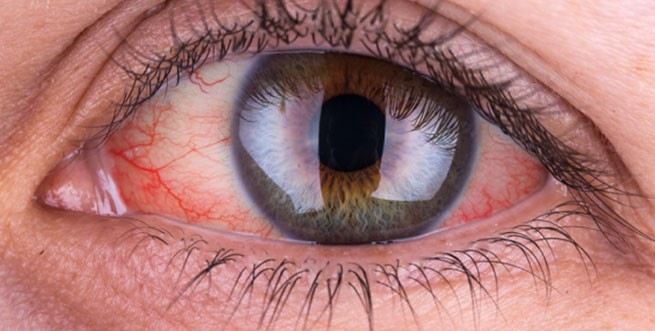Red eyes are a common and annoying condition that can be caused by anything from minor irritations to more serious causes.
Redness is caused by dilation of blood vessels on the surface of the eye, resulting in a noticeable reddish or pinkish tint. 15 most common reasons.
1. Dry eye occurs when the eyes do not produce enough tears or the quality of them leaves much to be desired, leading to irritation and redness. In addition, symptoms may include burning sensation, itching and sensitivity to light.
2. Allergy can cause inflammation and redness of the eyes. Common allergens include pollen, pet dander, dust mites, and mold. Allergic conjunctivitis often causes itching, watery eyes, and swollen eyelids.
3. Infections:
- Conjunctivitis – is an infection of the conjunctiva, the thin layer that covers the white part of the eye. It can be caused by bacteria, viruses, or allergens. Conjunctivitis usually causes redness, itching, and discharge.
- Uveitis – uhThis is inflammation of the uvea, the middle layer of the eye. It can be caused by infections, autoimmune diseases or injury. Uveitis can cause severe redness, pain, sensitivity to light, and blurred vision.
4. Eye strain. Prolonged use of digital screens, reading, or other work that requires looking at something at close range can cause eye strain, leading to redness. Eye strain can cause fatigue, headaches, and blurred vision.
5. Using contact lenses – nImproper use, such as prolonged use or improper cleaning, can lead to irritation and redness. Symptoms may include discomfort, a feeling of “something in the eye,” and increased tear production.
6. Injury eyes, whether it is a foreign object, a blow or a scratch, can cause blood vessels to rupture, resulting in redness. The condition associated with trauma is often accompanied by pain, swelling and possible changes in vision.
7. Glaucoma is a serious condition in which the pressure inside the eye rapidly increases, causing the eye to become red. This condition can cause sudden redness, severe pain, blurred vision and nausea, which requires immediate medical attention.
8. Blepharitis – is an inflammation of the eyelids, often caused by bacteria or skin conditions such as dandruff. It can cause the eyelids to become red and swollen, and the eyes may appear red.
9. Subconjunctival hemorrhage occurs when a tiny blood vessel bursts just under the conjunctiva, the clear surface of the eye. It can cause a bright red or dark spot on the white of the eye that looks alarming but is usually painless and not serious.
10. Irritating environmental factors. Exposure to smoke, dust, chemicals, or even chlorine from swimming pools can irritate the eyes, causing them to become red. This is often accompanied by a burning or stinging sensation.
eleven. Lack of sleep can cause red eyes. Lack of rest reduces the amount of lubrication in the eyes, causing irritation. Along with redness, lack of sleep can cause dryness, puffiness, and dark circles under the eyes.
12. High blood pressure can sometimes cause small blood vessels in the eyes to burst, causing redness. Although hypertension often has no symptoms, it can sometimes be detected by red spots under the eyes.
13. Medicines and other substances, such as decongestants and antihistamines, may cause dry and red eyes. Substance use such as alcohol or drugs can also cause red eyes. Caused by drugs, it is often combined with symptoms of dry eyes, and redness caused by alcohol can be accompanied by a hangover.
14. Autoimmune disorders. Diseases such as rheumatoid arthritis or lupus can cause inflammation in various parts of the body, including the eyes, leading to redness. Associated with an autoimmune disease, it is often accompanied by other symptoms such as joint pain or fatigue.
15. Hormonal changesespecially during pregnancy or menopause, can lead to dry, red eyes. This can include dry, irritated, and sometimes puffy eyes.







More Stories
Caution: Medicines That Increase the Risk of Sunburn
Diabetes: How much does risk increase for those who sleep in bright light at night?
Those who drink water from plastic bottles have an increased risk of developing type 2 diabetes